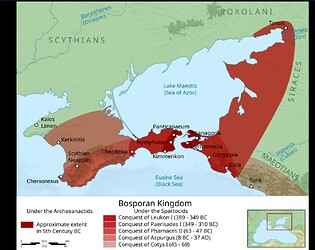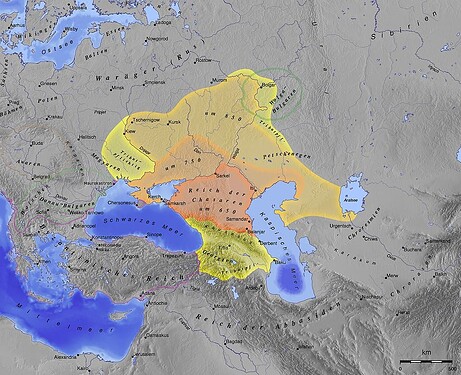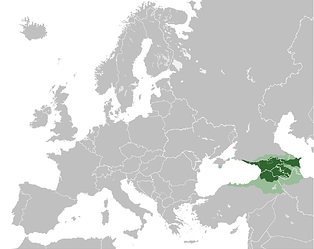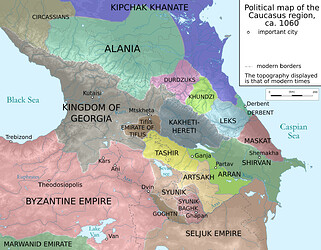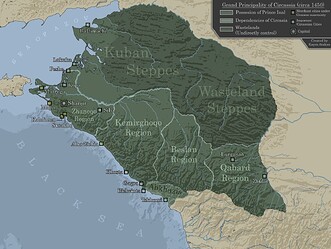About Caucasus
At least for Age of Empires IV, most major civs are based on kingdoms from the Middle Ages and early modern period, with a cultural identity that remains to this day, either in their descendants (Rus’ → Russia, Ottomans → Turks) or in memory (Byzantines, Order of the Dragon).
They are not based on races or ethnic groups as in AoE2.
Therefore, for Circassians, you would need to find kingdoms or confederations that existed during the game’s time period to represent them. And that have at least 1 unique unit.
Prologue: Circassia before the Fall of Rome
There was a greek Kingdom named the “Bhosporus Kingdom” (438 A.C.- 376 A.D), in Crimea and Circassian region, with Scythians tribes in their borders.
But between 300 and 400 AD, the area of Cirsassia was completely destroyed by the Huns. Its entire population was killed and all its buildings destroyed, leaving nothing but ruins.
The Goths themselves (Scandinavians from Sweden who migrated here), who were their neighbors, had to flee to continental Europe for fear of the Huns.
According to the book “WHY ABKHAZIA IS GEORGIA”, during the early Middle Ages (400-700 AD), there was no specific kingdom for the Circassians by fault of the Huns destruction; most lived in independent tribes (Alans, Durdzuks, Circassians, Khazars) who were slaves of the Huns hordes.
When Attila die in 453 A.D, many tribes revolt and migrated to many regions, incluedd Circassian, to found their own kingdoms.
Khanate of Khazaria
Around the year 600, a group known as the Khazars founded the Khanate of Khazaria (618–1048) in Circassia, bordering the Roman Empire (Byzantines) to the south and often allying with them against the Persians.
They were rivals of the early Islamic kingdoms, including the Rashidun, Abbasid, and Fatimid Caliphates.
However, their greatest enemy was the Rus’ peoples, especially the Principality of kyiv, which waged war campaigns against the Khanate between 960 and 1024, razing the capital and most of the Khanate’s cities.
It is known that the Rus’ attempted to wipe them out completely, and most of the survivors had to retreat south to the mountainous area bordering the newly founded Georgia.
Kingdom of Georgia (1004 - 1466)
After the Islamic invasion of the Byzantine Empire (634), the inhabitants of Circassia also faced the possibility of being invaded, and they were.
After 300 years of rule, a rebellion against the Abbasid Empire began. Under the leadership of the Bagrationi Dynasty, many of the Circassians joined the Iveri and founded the Kingdom of Georgia in 1004 AD.
The kingdom reached its peak during the so-called “Golden Age of Georgia,” founded by David IV in 1122, with Tamar the Great as its last representative monarch until 1213.
Georgia was invaded by the Mongols, defeated, and converted into their vassal state in 1238. However, the Ilkhanate was not well-organized administratively, civil wars erupted, and it fragmented in 1335, leaving the Georgians free again.
However, the Georgians were unable to fully restore their kingdom, as in 1380, Tamerlane, seeking the title of ghazi, invaded Georgia several times (seven campaigns over twenty years), besieging the capital and devastating the country, committing a genocide of the Georgians.
The Georgians would put up a fierce resistance to Tamerlane, being one of the nations that rebelled and defeated his armies several times, but they eventually surrendered after the seventh invasion.
After Tamerlane’s death in 1405, there was little political unity in what remained of Georgia, and after a civil war in 1465, the kingdom was officially divided into three smaller kingdoms and five principalities.
Alania
The Alans are curious. They originated as one of the barbarian peoples who migrated from Eastern Europe to the Roman Empire, first fleeing the Huns, then becoming their vassals, more out of fear than loyalty, and then rebelling against the Huns after Attila’s death to gain their freedom.
Once free, they went in search of their own lands. They apparently migrated to the Caucasus region (previously devastated by Attila) and founded the Kingdom of Alania (~850 AD - 1240 AD).
It is known that the Alans fought alongside trained war dogs, of the so-called Alana breed. It is believed that modern Alans are descendants of these dogs.
The Christianized kingdom was a neighbor of Georgia, and they often allied against the Arabs and the incursions of the Pechenegs and Kipchaks.
They would also be fragmented due to civil wars following the Mongol invasions of 1238, and the betrayal of many royal members, who conspired with the Mongol invaders. The Mongols would include many Alan soldiers in their Keshig, or royal guard.
Golden Horde
During 1240-1395, the Golden Horde would take over the Caucasus region.
After Tamerlane invaded Russia to attack Toktamish, leader of the Golden Horde, the towns in the area were also plundered.
Circassia (1427-1452)
After the disintegration of the Kingdom of Georgia, King Inal the Great unified the Circassian peoples of the area and, in a series of military campaigns against Georgians, Tatars, and Genoese, created the Kingdom of Circassia.
The kingdom did not last long, as he divided it among his many sons, and these principalities remained independent until the subsequent events of his war with Russia.
